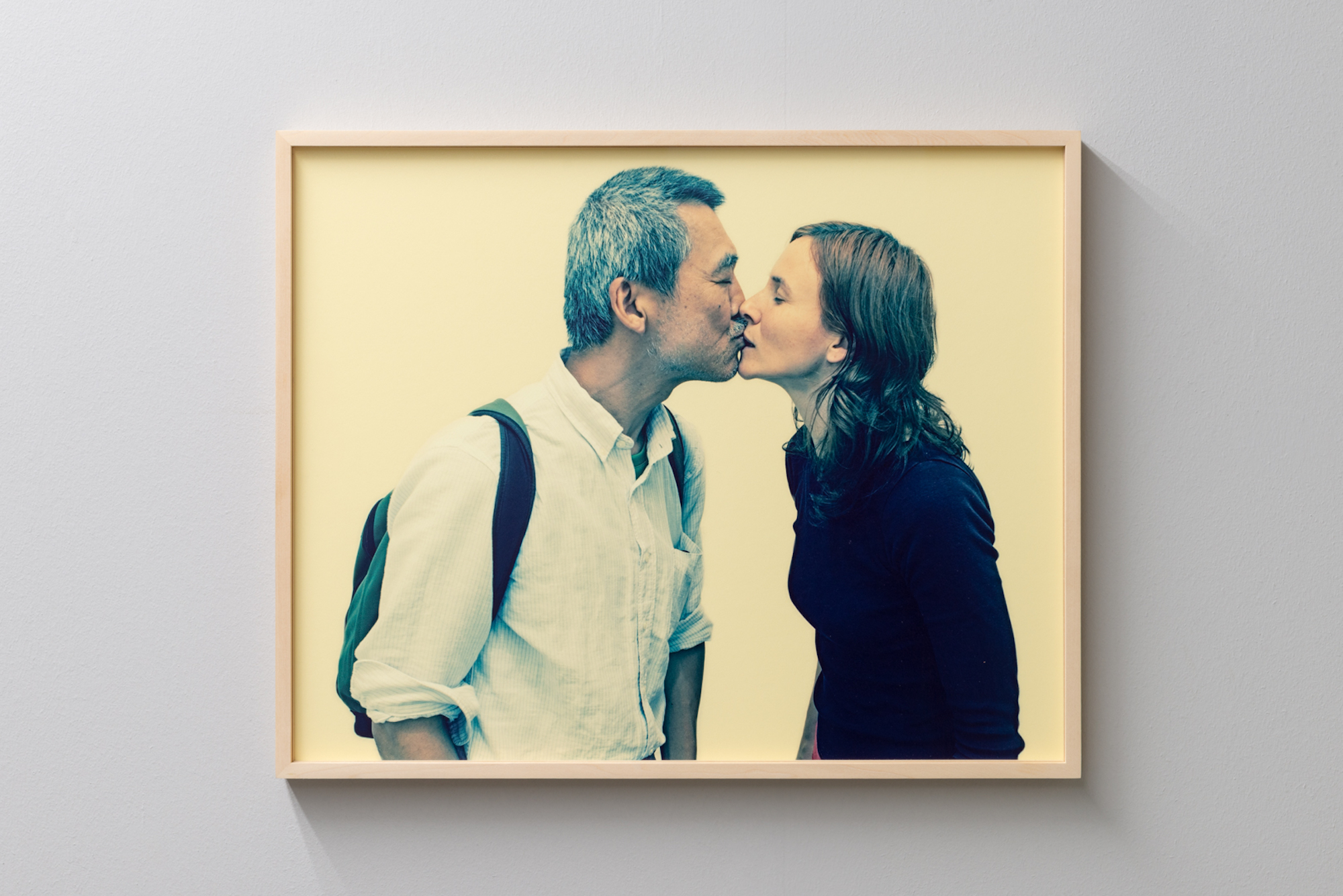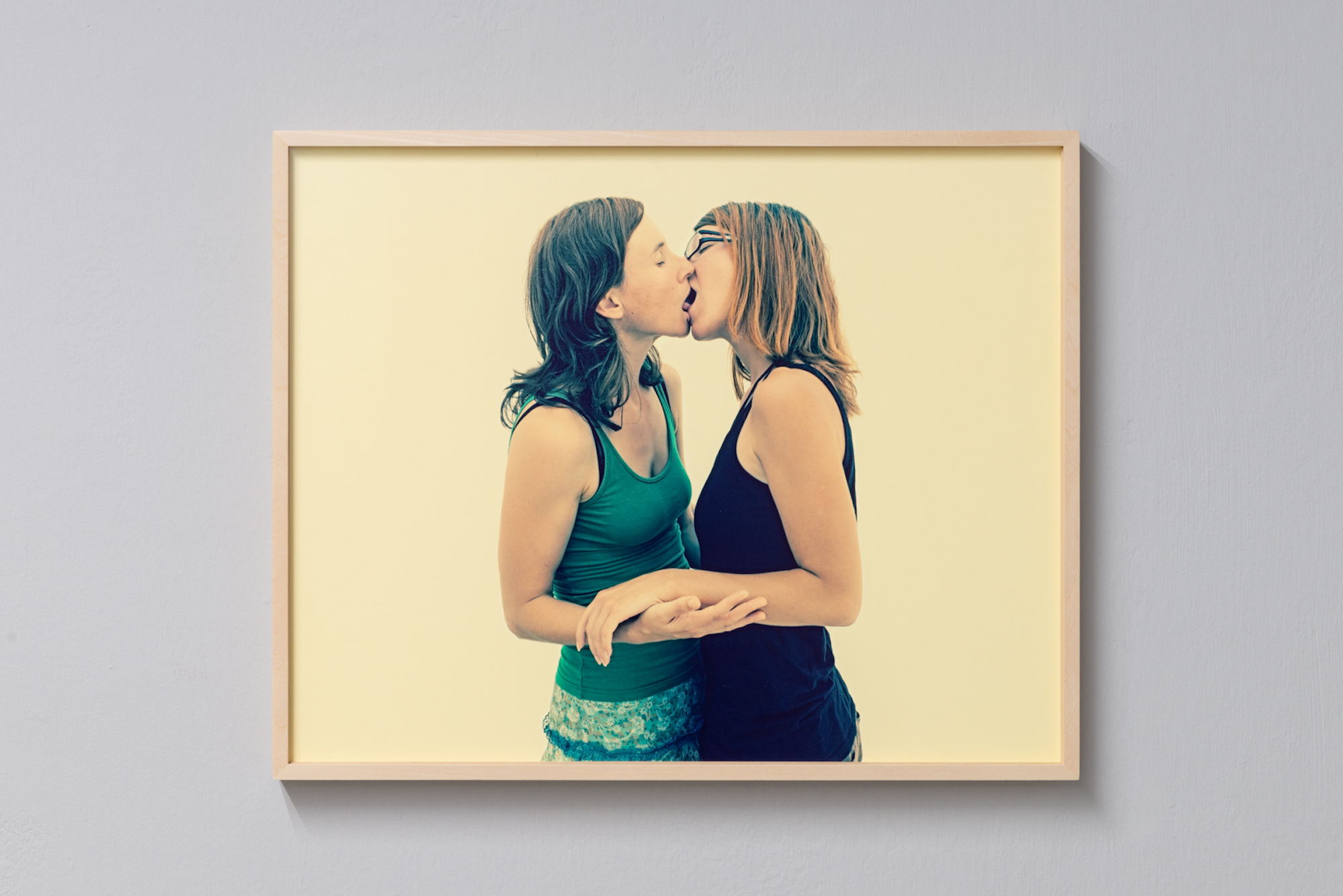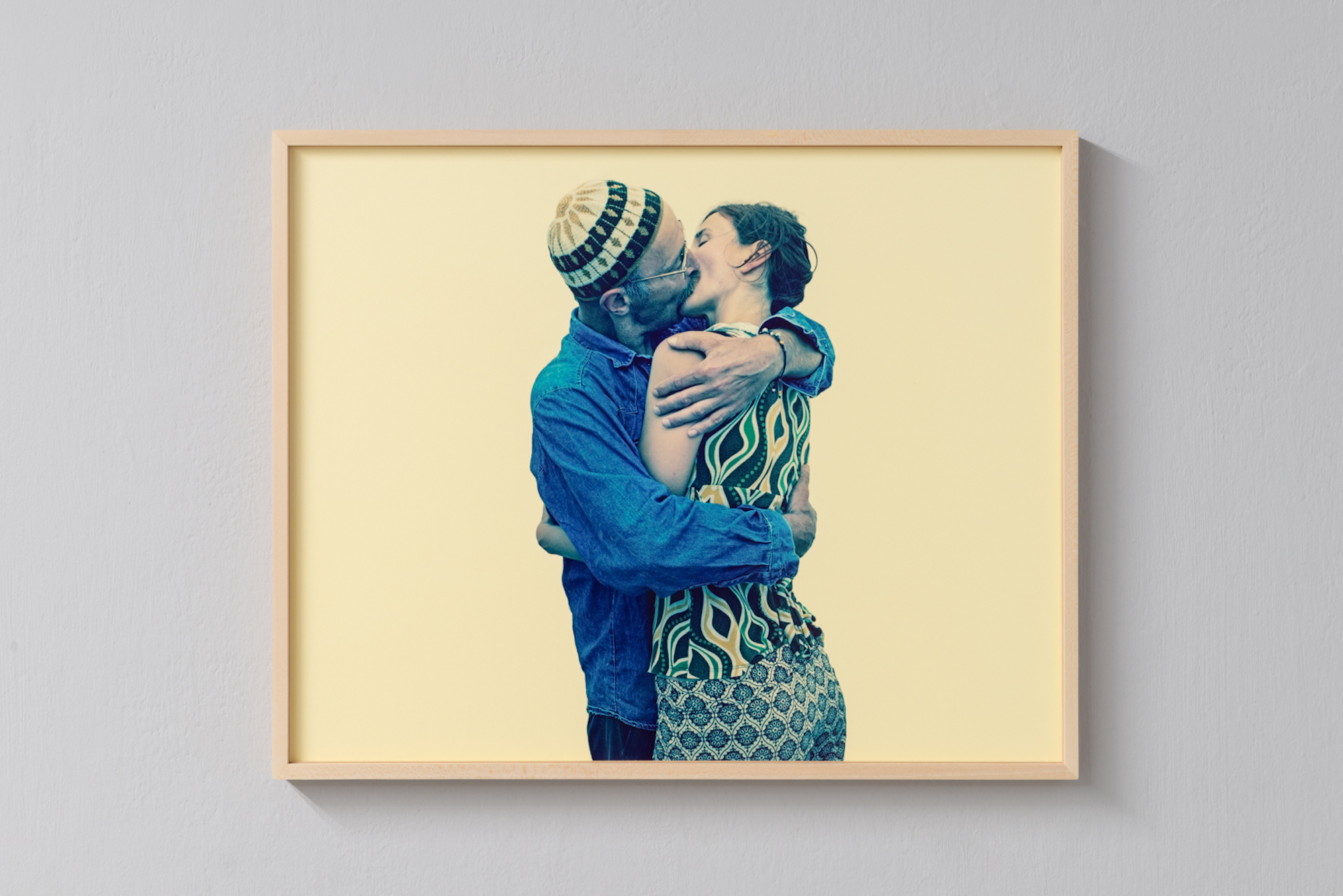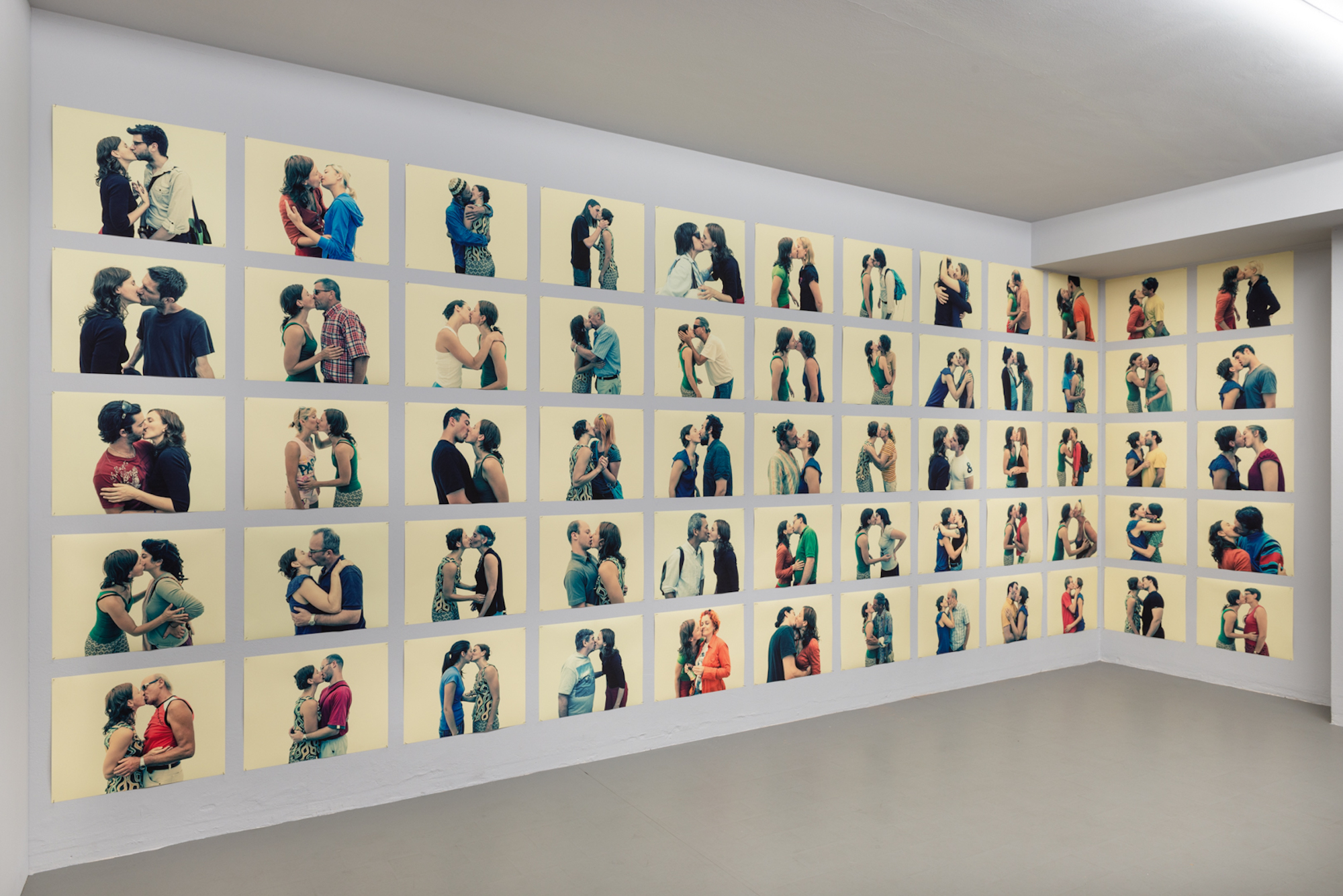Il progetto della mostra, KISSES, nasce guardando la documentazione fotografica prodotta da Alessandro Ruzzier in occasione di un’azione performativa itinerante realizzata nel 2009 in alcune città della Slovenia. Il punto di partenza è una riflessione sull’intimità e come essa è considerata nella società. L’azione si è svolta in uno spazio delimitato e protetto dalla vista di chi sta all’esterno (una struttura a forma di cubo di 3 metri di lato, montabile in 20 minuti e posizionabile in una galleria, in un teatro, in una libreria, in uno spazio pubblico all’aperto…). Il visitatore è invitato ad entrare nello spazio, informato preventivamente, su quello che accadrà, che ci si aspetta una partecipazione attiva e che può rinunciare in qualsiasi momento. Il compito della performer, Vlasta Veselko, sarà di portare il visitatore all’atto del bacio, un bacio in bocca, il massimo dell’intimità, almeno nella maggior parte della società occidentale.
Guardando le immagini di baci autorizzati, oltre sessanta, ed ascoltando il racconto di Alessandro nella veste di testimone, di voyeur autorizzato, non solo del bacio, ma di tutto ciò che succede prima e dopo di esso, di tutte le sensazioni possibili determinate da quella situazione: paura, resistenza, rifiuto, reticenza, impotenza, attrazione, impegno preso (baciare, essere baciata), stanchezza, odore, noia, aspettativa, timore della reazione dell’altro, pensiero che l’altro possa essere malato, sporco, ubriaco…e tanto altro, l’attenzione si sposta sulla rappresentazione di un evento unico e irripetibile dello spazio e del tempo. Ogni inquadratura rappresenta lo spazio minimo possibile tra due persone. La prossimità spaziale, il sapere e il sentire dove l’Altro è, diviene fondamentale per il rapporto umano che si può stabilire. Uno spazio contemporaneamente fisico ed emotivo, il bacio in bocca, che appartiene al corpo ma pure alla nostra anima, quella “psyche” consegnata all’Altro, nel momento in cui lo bacio. Nel bacio in bocca sono coinvolti contemporaneamente tutti i sensi: la vista, l’odorato, il gusto, il tatto e l’udito assaporando in questo modo in tutto e per tutto l’altra persona, in quel luogo e quell’istante.
Tutte le immagini di “KISSES” sono uguali, stessa dimensione, stesso sfondo, stessa azione, sono rappresentati due soggetti, di cui uno sempre presente, e pure sono tutte completamente differenti, uniche, irripetibili. Irripetibili come lo sono i baci veri, legati sempre ad uno spazio ed un tempo, ma inesauribili e mai neutrali. Baci che prevedono sempre e solamente l’Altro. Il bacio rappresentato è sicuramente un’alterazione della realtà, ma il muro di baci allestito per KISSES, forza il nostro sguardo e ci spinge oltre il bacio estetico e ci mostra anche il bacio etico, non separatamente, ma contemporaneamente, portandoci a pensare a questa azione, pratica sublime, massimo grado del linguaggio e del dialogo tra due persone. Ripensare a questa azione, recuperandola dalla nostra memoria, può significare anche recuperare il nostro rapporto verso l’Altro, ma anche uscire da un pensiero forte costruito nel Novecento e di cui subiamo, ancora oggi la deriva, che è la supremazia della necessità alla libertà nel nostro esserci. Il bacio in bocca è, anche solo in quell’istante, il nostro “essere per la vita”, “essere per l’amore”, l’alternativa a quell’”essere per la morte” di Heidegger che ci è stato indicato nel suo grande capolavoro “Essere e Tempo”. L’Amore e la Morte, le “due cose belle”, di cui parla Leopardi rappresentano l’essenza della dramatis personae e se l’amore è espressione di libertà e la morte di necessità, il bacio, il bacio in bocca, lo spazio minimo possibile tra due persone, è la possibilità, il soffio vitale (psiche), di rinnovare sempre senza paura di esaurimento la supremazia della libertà sulla necessità.
“Bacio dato non è mai perduto”
(proverbio italiano)
Stefano Monti
The exhibition project, KISSES, was born from the photographic documentation produced by Alessandro Ruzzier during his touring performance art project held in a number of cities in Slovenia in 2009. The starting point is a reflection on intimacy and how it is considered in society. The performance took place in a space delimited and protected from the view of those who were outside (a cube-shaped structure of 3 meters on each side, which can be assembled in 20 minutes and can be positioned in a gallery, theatre, library or an outdoor public space …). The visitor was invited to enter the space, they were informed in advance about what was going to happen, that their active participation was expected and that they can stop any time. The task of the performer, Vlasta Veselko, was to entice the visitor into the act of kissing, a kiss on the mouth, the greatest form of intimacy, at least in most of western society. Alessandro was a witness and authorized voyeur, not only of the kiss, but also of everything that happened before and after it, of all the possible sensations evoked by the situation: fear, resistance, refusal, reticence, helplessness, attraction, the commitment made (kissing, being kissed), tiredness, odour, boredom, expectation, fear of the other person’s reaction, thinking that the other person could be sick, dirty or drunk … and much more. When we look at the over sixty images of these authorized kisses, and listen to Alessandro’s experience, our attention shifts to the representation of an event that was unique and unrepeatable in space and time. Each image represents the minimum possible space between two people. Spatial proximity, knowing and feeling where the Other is, becomes fundamental for the human relationship that is established. A space that is physical and emotional at the same time. The kiss on the mouth, which belongs to the body but also part of our soul, the “psyche” delivered to the Other in the moment of the kiss. All the senses are involved in a kiss on the mouth: sight, smell, taste, touch and hearing, savouring the other person in every respect, in that place and that instant.
All the images in “KISSES” have the same format: the same size, the same background, and the same action. Two subjects are shown, one of whom is always present. However, at the same time they are all completely different, unique and unrepeatable. Unrepeatable as true kisses are, always linked to a space and a time, but inexhaustible and never neutral. Kisses that always – and only – require the Other. The kiss portrayed is certainly an
alteration of reality, but the wall of kisses set up for KISSES, forces our gaze to push us beyond the aesthetic kiss in order to also shows us the ethical kiss, not separately, but at the same time. This leads us to consider the nature of this action, sublime practice, and the highest degree of language and dialogue between two people. It invites us to reconsider this action and recover it from our memory. This can mean recovering our relationship with the Other, but it can also come out of a dominant idea generated during the twentieth century which we still suffer for, and which still bears influence today: the supremacy of the need for freedom in our existence. A kiss on the mouth is, even only for an instant, our “being-towards-life“, “being-towards-love“, the alternative to that “being-towards-death” Heidegger spoke of and outlined in the his great masterpiece “Being and Time”. Love and Death – the “two beautiful things” in the words of Leopardi – represent the essence of the dramatis personae and if love is an expression of freedom and the death of necessity, a kiss, a kiss on the mouth, the minimum possible space between two people, is a possibility – the vital breath (psyche) – of renewing the supremacy of freedom over necessity without fear of exhaustion.
“A kiss, once given, is never lost.”
(Italian proverb)
Stefano Monti




For all SMDOT/contemporary art exhibitions, a playlist will be created by Steve Nardini, the heart and soul of KOBO SHOP and a great musical expert. The following songs and artists have been selected for Alessandro Ruzzier and his solo exhibition "KISSES"